https://www.youtube.com/watch?v=uYb5j7GJnFQ
Quilty - Tying a Quilt—Quilting How-to

Yeah .
Quilty is brought to you by a pqs handcrafted quilting machines or , or Italian thread perfectly suited for all your quilting projects .
Baby Lock .
For the love of sewing .
Clockworks , inspiring creativity with art on fabric , hovel , sewing .
When you need to cut it close .
Choose hovels P and B our fabrics , your lifestyle quilt , the urban quilt space .
Quilty .
Remember this quilt ?
It's almost done on today's episode .
We're going to show you one method for finishing it .
Join us tying a quilt is a way to join the sandwich , the backing , the batting and the top of your quilt to join those pieces together and to finish your quilt and it's totally good in a pinch .
And we're gonna show you how to do it today .
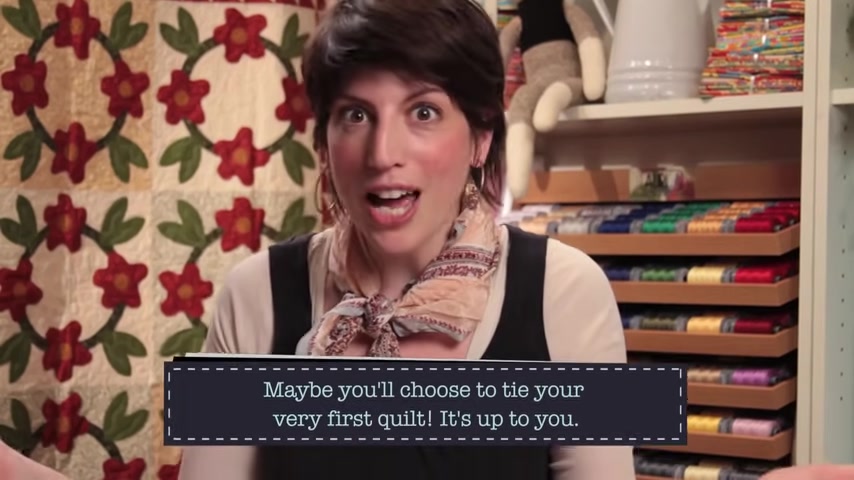
Ultimately , we hope that you will try a little machine quilting or , um , even hand quilting or send your quilt to a long armor to finish .
But sometimes you tie a quilt and that's totally cool .
And so we're going to show you how to do it today .
Um , the first step , uh , is to get your completed quilt top , um , basted and , and put together with the sandwich in a secure way .
Um So before me , I have a little quilt top that we did .
You might remember it from an earlier episode of Quilty .
This is the stripper quilt that we did with Shana a few months ago .
And we had all these scraps and we put them together in these long strips and it's kind of the perfect size for a baby quilt .
I mean , this is a sassy baby , not like any baby quilt you've ever seen before , but it's a quilty baby quilt .
And so we're gonna , we're gonna tie it .
I'm gonna show you how to do a little tie on a quilt with this .
So the first thing you do is put it down , uh , on top of the batting and the backing .
So let's take a look down here .
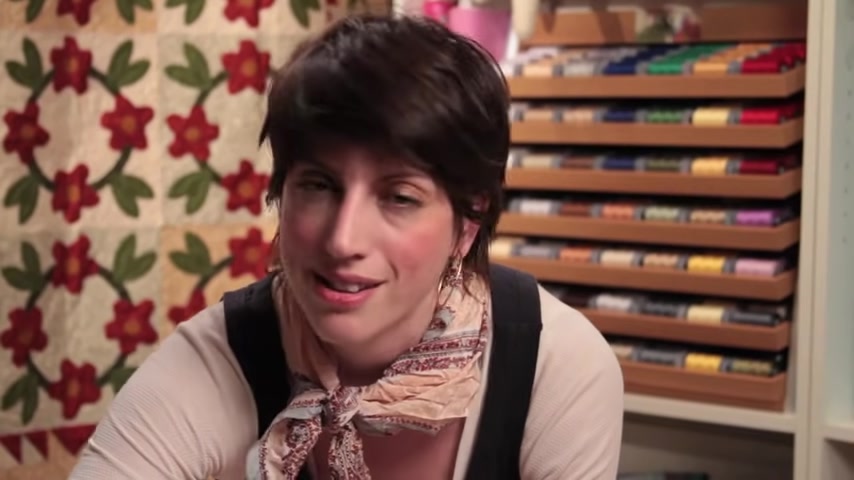
The first , uh , uh , layer that goes down is your backing fabric and you secure it on a really , um , flat surface with tape .
I like to use like a duct tape or a masking tape .
You can do this on the floor .
You can do it on a huge card table .
It depends on the size of your quilt .
But I've chosen , um , to piece the back of this quilt .
Actually , I used some black that was in the quilt somewhere or something that was similar and a piece of black that I had and I pieced it all together so that it was a little bit bigger , a few inches bigger around than the quilt top itself .
Ok .
On all sides , you tape that down onto your table and I'd secure it , like definitely one in each corner , one on the sides .
Make sure it's not gonna budge anywhere .
You don't have to pull it really tough , but just lay it down , make it secure , then comes your batting and this is a really nice soft natural batting that I use .
And that needs to also be cut bigger than on , on all sides than your , than your quilt top .

Uh You know , at least an inch and a half , maybe a little bit more , just enough to be able to fold over to trim and fold over for your binding later .
And then your quilt top goes on top and then you base it .
And we've done this once on quilty before when we were showing how to prepare uh a piece of , of quilting for machine quilting and for hand quilting .
But , um , we're gonna do it one more time here as we show you because this is the same process when you tie a quilt .
These are basting pins .
When you get all your layers down on your flat surface , you need to secure them with basting pins .
That's actually a regular safety pin .
But that's a good thing to show you that's a regular safety pin .
And this is a special quilters basting pin .
And we've talked about this before , but that has a bend in it and the reason why that's awesome is because when you're putting your pin through , just do it right here .
When you're putting your pin through , it's got this angle .
You want to go through all three layers and bring it up and that bent pin is awesome for that .
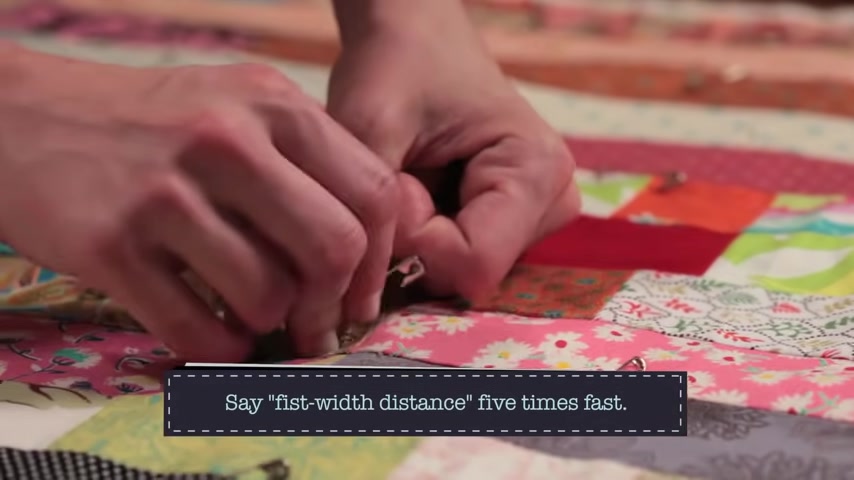
So that is a very good supply to have in your quilting tool kit .
So you put those pins down in your , in your quilt top .
And the rule is it kind of varies .
But usually if there's about a fist width distance between your pin , like in any direction , your basting pin , like I could probably use one right about there .
So I'd put one in there .
You make sure you go through all your layers , you don't want to miss a layer and you get those put in , OK ?
And then you can take your tape off and you're , you know , you're secure .
OK ?
Um And then to tie your quilt , you don't use regular thread , don't use quilting thread .
So to thread this .
So this is a , um I found this thread on the clearance bin uh at the uh at the craft store .
It's like a poly blend .
It's variated .
I thought that would be good for uh for this quilt kind of pinky and cute , but it's got that scrappy look to it .
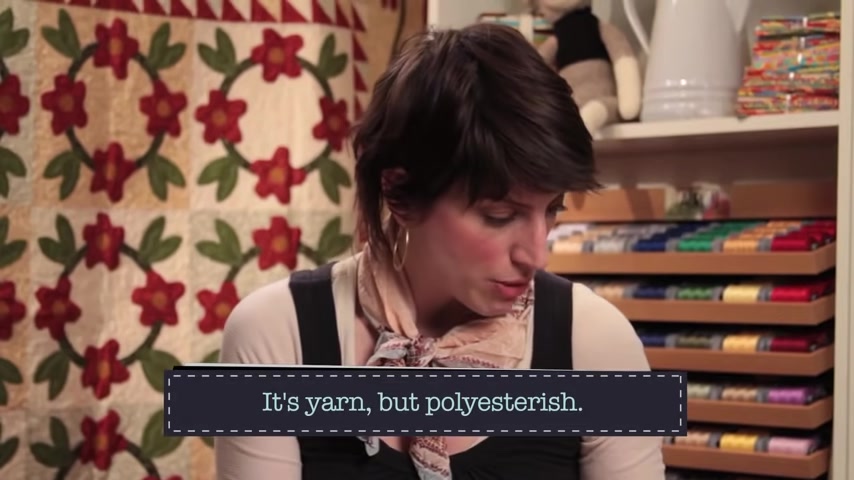
So you cut a piece of this thread , um , you know , a piece that long enough to work with and the needle that you would use to tie .
This quilt is gonna be different from just a regular small needle .
Obviously , it's thicker thread .
You're gonna want a better needle .
I'm gonna lay it down right here .
This is , um , I think this is a basting needle .
You could use , uh , a tapestry needle or a wool applique needle .
Anything that's bigger , it's got a little heft to , it is gonna be a good choice for you .
Sometimes it can be hard to thread the guy because the , the yarn and you can use yarn , you can use , uh , embroidery floss .
Uh , you can use pearl cotton .
Anything that's got some , um , some weight to it will be fine , but that can be hard to thread through that needle .
So a little trick is to take a piece of thread , just regular quilting like sewing thread that you would put in your sewing machine and make a loop .
Ok ?
Just a little tiny loop .
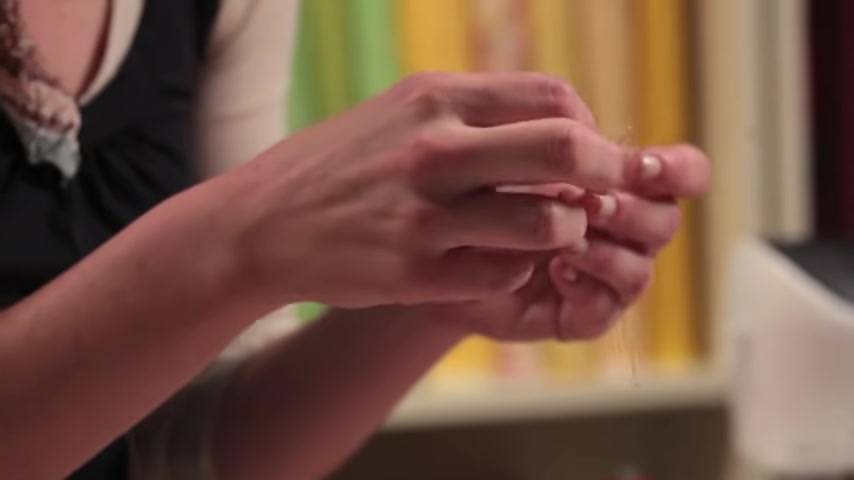
We'll get a close up of it and thread that loop through your needle .
Do this .
Do you wanna know something really gross ?
This is a tip .
This is a tip .
I'm gonna do it .
I'm gonna do it grease on your nose .
This is some , one of the first things I ever learned about quilting .
I know .
I can't believe I'm doing this on camera .
But the fact of the matter is is that the grease on your nose helps make a point that will get , see .
It's , it's gonna work .
It's kind of waxy .
And quilters have used bees wax in the past to make their thread thicker .
See , I got it .
Um , but that's , that's like a tip .
I mean , it worked right .
I couldn't get it threaded and then just use a little bit of , you know , grease off your nose and he'll do it anyway .
So , once you have your loop threaded through your needle just like that , I'm gonna put it down on this , this area too .
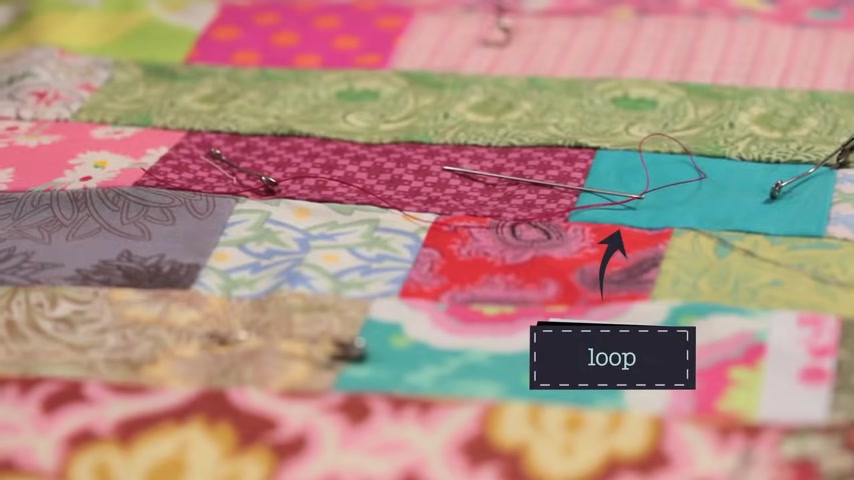
See , I've got this loop through my thread then just run your floss or your Yeah , whatever your yarn that you're using is through that .
It's like you're making your own needle threader and then pull the loop true through just like that because it's really hard .
I mean , if it's hard enough to get that little piece of thread through this needle , it's really hard to get the yarn through .
But see , does that make sense ?
A little loop thing ?
Little loop trick ?
OK .
So once you have your yarn ready to go , you're ready to tie .
So I'm gonna go back into this little blue area because it's easy to see .
And you're going to go down through all four , all three of your layers and then come back up not too far away .
You don't want to take a big bite of fabric .

This is probably plenty and you pull through , you have to tug it a little bit , but you have to be gentle because you don't want to be tearing anything and I'd leave , you know , few inches and I go back down through .
You really want this to be secure .
I'd come back down once and come back up one more time .
Right about where you went , where you took your 2nd , 2nd stitch here .
So you're coming back through , you just want to make it a little , little extra secure , especially if it's a baby quilt .
You want it to be very secure .
Ok ?
And then you can tie it off .
Now some people will use a surgeon's knot .
It's a different kind of knot .
I just do a regular square knot .
I think it's ok .
It works for me .
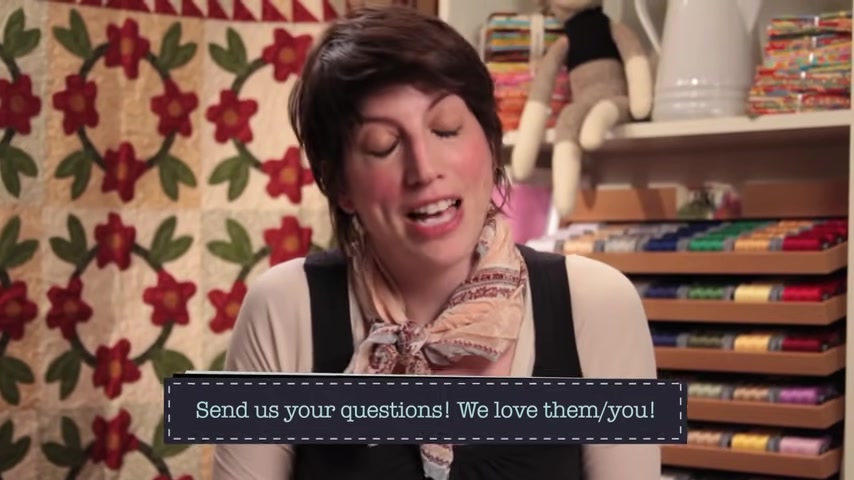
It's worked for a lot of quilts in the past and then trim it off and about every , everywhere you have a pin , I would say double that amount of ties .
Just make sure you're getting a very secure .
Um a , a very , you want to make sure all your layers are securely tied .
So that's how you do it .
It's pretty self explanatory , but sometimes it's nice to see that prep , work done and now that you have the nose grease tip , you're set for life .
So um tie a quilt if , if you , if you like it's a , it's a fast way to finish it for more tips on quilting .
If you're a rookie quilter or an experienced one , we've got lots of information for you and we love sharing it with you .
So , join us on Facebook and Twitter and we'll see you next time .
Bye .
Quilty is brought to you by a pqs handcrafted quilting machines .
RFLRF Italian thread perfectly suited for all your quilting projects .
Baby Lock .
For the love of sewing .

Cloth works inspiring creativity with art on fabric , hovel , sewing when you need to cut it close .
Choose hovels emv our fabrics , your lifestyle mythology , the urban cloud space .
Guilty .
Are you looking for a way to reach a wider audience and get more views on your videos?
Our innovative video to text transcribing service can help you do just that.
We provide accurate transcriptions of your videos along with visual content that will help you attract new viewers and keep them engaged. Plus, our data analytics and ad campaign tools can help you monetize your content and maximize your revenue.
Let's partner up and take your video content to the next level!
Contact us today to learn more.